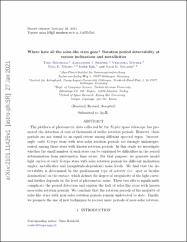Where have all the solar-like stars gone? Rotation period detectability at various inclinations and metallicities

Göster/
Erişim
info:eu-repo/semantics/openAccessTarih
2021Yazar
Reinhold, TimoShapiro, Alexander I.
Witzke, Veronika
Nèmec, Nina E.
Işık, Emre
Solanki, Sami K.
Üst veri
Tüm öğe kaydını gösterKünye
Reinhold, T., Shapiro, A. I., Witzke, V., Nèmec, N. E., Işık, E., & Solanki, S. K. (2021). Where have all the solar-like stars gone? Rotation period detectability at various inclinations and metallicities. The Astrophysical Journal Letters, 908(2), L21.Özet
The plethora of photometric data collected by the Kepler space telescope has pro moted the detection of tens of thousands of stellar rotation periods. However, these periods are not found to an equal extent among different spectral types. Interest ingly, early G-type stars with near-solar rotation periods are strongly underrepre sented among those stars with known rotation periods. In this study we investigate whether the small number of such stars can be explained by difficulties in the period determination from photometric time series. For that purpose, we generate model light curves of early G-type stars with solar rotation periods for different inclination angles, metallicities and (magnitude-dependent) noise levels. We find that the de tectability is determined by the predominant type of activity (i.e. spot or faculae domination) on the surface, which defines the degree of irregularity of the light curve, and further depends on the level of photometric noise. These two effects significantly complicate the period detection and explain the lack of solar-like stars with known near-solar rotation periods. We conclude that the rotation periods of the majority of solar-like stars with near-solar rotation periods remain undetected to date. Finally, we promote the use of new techniques to recover more periods of near-solar rotators.
















